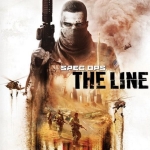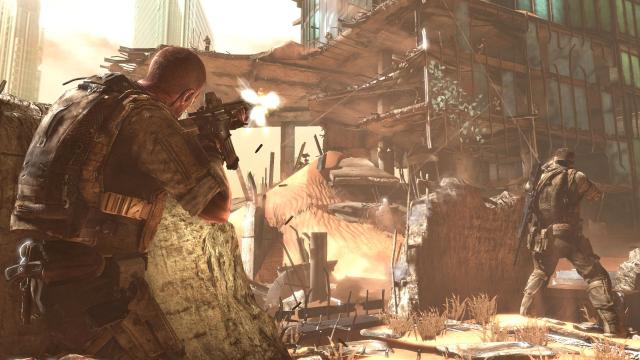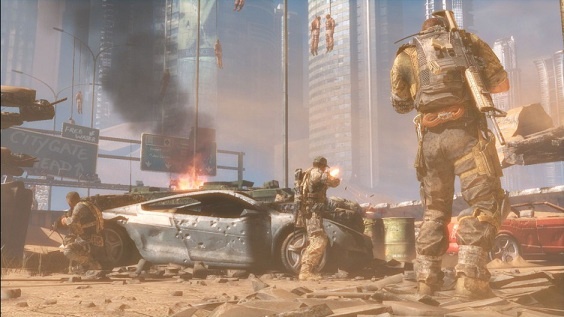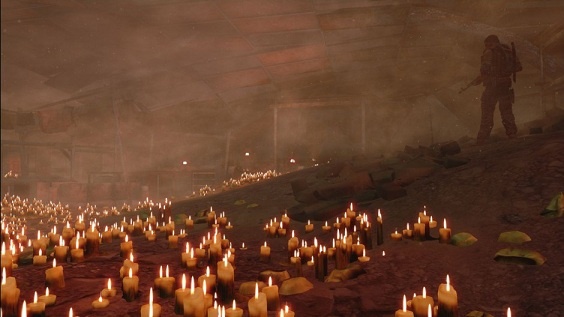
Sometimes a game just creeps up on you and blows you away. I’d somehow managed to miss much of Spec Ops’s build up so went into this review relatively blind, wondering if this was going to be just another military shooter. And yet after spending a couple of weeks with it there’s no denying that Spec Ops: The Line is one of the year’s big surprises.
As I found with Homefront, the most memorable part of Spec Ops is the story. The game is set in the millionaire’s playground of Dubai, and yet this isn’t the Dubai you’ll have visited or seen in the travel brochures. Huge sandstorms have torn the city apart, and from being one of the world’s most desirable locations it’s now the centre of a mass evacuation attempt. A delta team of three US soldiers enters Dubai with the intention of having a look round the see what’s going on with the evacuation. But as the situation escalates and orders start becoming more meaningless things take a series of breathtaking twists towards an ending (well, several different endings depending on choices you make) that will stick in your mind for quite some time.

As for those choices I just mentioned, don’t expect Mass Effect levels of interaction, but throughout the game you’re forced to make some very difficult moral decisions. There’s never a blatantly right or wrong choice to make – more often than not you’ll piss someone off either way – but you’ll wrestle with your conscience to decide which way to go. These decisions build up your attachment to the scenario that’s being played out in front of you as the squad start to fight their own mini war within the group while struggling to maintain the teamwork. It’s difficult to express just how good the story is without giving too much away, but it’s genuinely one of the most solid and engrossing plots you’ll find in a game.
The action itself is intense and hard-hitting. From the very first moment when you’re thrown into a helicopter battle, gunning down enemies with the on-board machine gun, the action is loud and fast. The gunfights themselves are more often than not of a similar ilk, and whether you’re in a huge open space or the tight confines of a smashed up office the constant shouts from your squadmates and the enemies bring home the desperation that has gripped Dubai. Enemies are smart too, using grenades to flush you out of cover and sending units to flank your position, meaning that it’s very tough to stay in one place and pick off everyone around. Your cover isn’t always indestructible either, so choosing the right place to hide is every bit as important as making sure you keep your accuracy up.
The cover mechanic is quickly becoming a make-or-break in 3rd person titles, and the system employed in Spec Ops is a pretty mixed bag. Holding the sprint button as you approach cover will have you sliding behind whatever object you’re hiding behind, letting you run out of trouble and get your head down in one fluid movement. Popping out of cover is quite flexible too, with a Mass Effect style system allowing you to dash across to alternative cover, slip out of cover into a forward movement or vault over the offending item to move on. Shooting works quite nicely as well, with blind firing taken care of pretty well and a well developed method of sticking your head up to take pot shots at the enemy. Anyone who’s ever played Uncharted will feel at home, although having the melee attack mapped to the same button as the vault will mean you’ll occasional take a swing at a pile of sandbags instead of leaping over it which apart from putting you at risk of getting killed also makes you look like a bit of a cock.

The other problems here turn up when you want to just move out of cover slowly and subtly. Detaching from cover is pretty tough, and more often then not will leave you standing bolt upright in the middle of a firefight, just waiting for a well judged head shot from a friendly nearby sniper. Given that there are a fair few occasions that you’ll need to move your position without being able to dash automatically to another safe area, this is a bit of a pain and can lead to some frustration as you start to panic and get shot a lot.
What makes this tougher is the environments you’ll find yourself in – this isn’t a problem as such, it’s just that everything looks so good it’s easy to get distracted as you try and take in your surroundings while trying not to end up flat on your back. One minute you’re in the sand-covered remains of a once great area, the next you’re stepping through piles of rotting corpses on your way to a lush hotel with gleaming floors, glass walls and fancy fittings. This does an amazing job of giving you the scale of what has happened here, showing both the glamour before the storms, and the horrific outcome of man and nature doing their best to screw everything up.
And then there’s the soundtrack, which is generally your standard dramatic background music that ramps itself up as things kick off and get nasty, only that’s not all. Entering a run-down hotel and fighting bad guys while Hush by Deep Purple blares out over the meaty sound system is quite a surreal (and very creepy) experience. This bizarre radio transmission continues on and off throughout the later parts of the game, with the DJ taunting you between songs. When you’re massively outnumbered later on the last thing you’d expect is Martha Reeves to chip in, but the booming Nowhere to Run somehow manages to make you feel like you’re really up against it. It’s impressive just how effective this style of music is, and whether that’s down to the way they’re used (something you can only realise by playing the game and feeling how it affects you) or the fact you just don’t tend to get Motown songs in your average shooter, it sure as hell does its job.

There’s a fair few online modes to keep you busy, some of which unlock as you make progress through the usual method of earning XP. You’ve also got the usual array of weapons and equipment to earn as well, and the leveling is paced sensibly so as to not reward you for every last little thing you do. Whether it keeps you hooked or not is questionable, but the 4-on-4 games are enjoyable and a bit different to usual huge teams found in most shooters.
And this is why I found it so similar to Homefront. While it’s not the longest campaign in the world and has its occasional issues, it’s the storyline and methods used to engross the player that make Spec Ops such a memorable experience and make the problems fade into nothingness. If you manage to hook yourself into the online modes you’ll definitely get the most out of this, but you should really look out for it even if you just want to give the single player a shot. It’s a very impressive package that’ll leave you staring at the screen open-mouthed wondering just what the hell just happened.
Reviewed on PS3


Sounds good – I’m looking forward to playing this now!